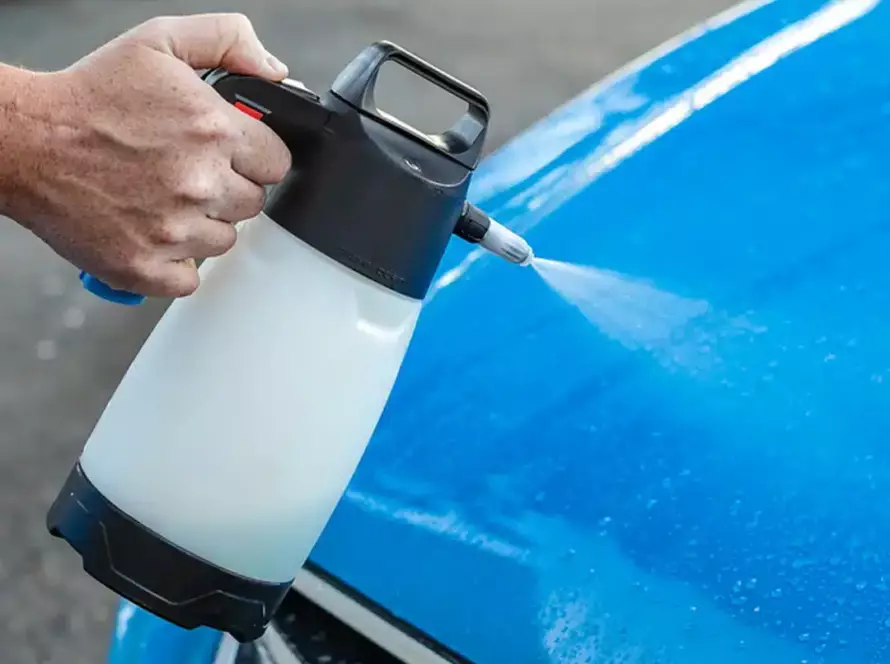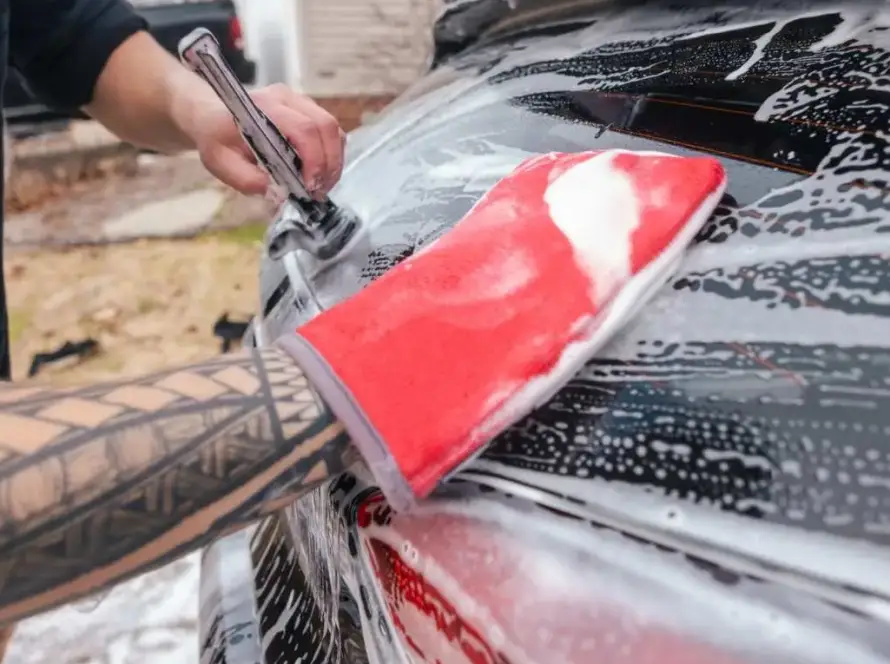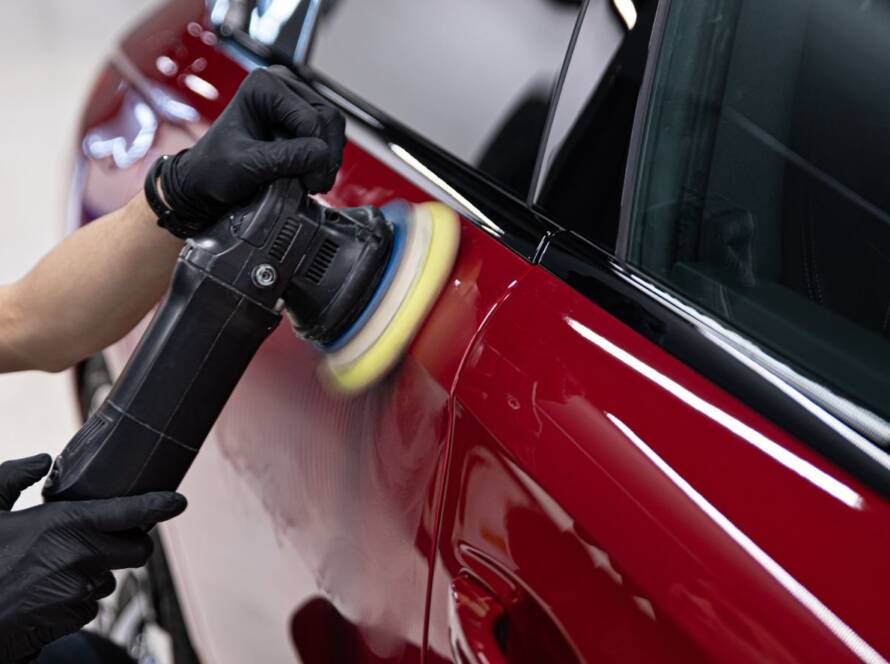Maintaining your vehicle’s exterior requires more than regular car wash, it could use the added protection provided by waxing. Car wax keeps your vehicle shiny and shields the paintwork from harmful UV rays, dirt, and harsh weather. This protective layer acts as a barrier over your car’s clear coat, preventing fading and protecting against contaminants like bird droppings, rain, salt, tree sap, and dirt particles.
Regular wax application enhances your vehicle’s appearance and can boost its resale value, making it an essential part of car maintenance. Think of wax as sunblock for your car!
Types of Car Wax to Use
When learning how to wax a car, there are several type of wax options to choose from. Each car wax offers unique benefits:
Paste Wax: The most traditional type of wax, available in both natural carnauba and synthetic formulations. Premium carnauba paste wax, made from Brazilian palm leaves, delivers the deepest, richest shine that makes your vehicle’s paint pop. Synthetic paste wax offers enhanced durability and chemical resistance. Both types provide paint protection lasting 4 weeks to 2 months and achieve a showroom-quality finish. Due to its thicker consistency, paste wax requires more effort to apply but delivers a nice gloss and depth.
Liquid Wax: A blend of natural waxes and synthetic polymers that offers solid UV protection, helping to prevent paint from fading and discoloring. Liquid wax generally protects for 1 to 3 months, with some polymer-heavy formulas lasting up to 6 months. This liquid form is easier to apply than paste wax, but doesn’t achieve quite the same depth of shine. The thinner consistency makes application more convenient.
Spray Wax: This convenient wax option allows quick touch-ups between major wax applications. While spray wax doesn’t last as long as paste wax, it’s perfect for maintaining that glossy finish between thorough waxing sessions.
How Often Should You Wax Your Car?
To maintain the protective benefits and shine that comes from car wax, it’s important to wax your car regularly. How often you should wax varies based on where your car is stored and weather conditions in your area. Vehicles kept in garages won’t need to wax as frequently as cars exposed to outdoor elements regularly.
If you’re living in an area with harsh conditions for waxing, it would be wise to wax your vehicle more often. Fluctuating temperatures and extremes of heat or cold can impact your car’s paintwork negatively. Most car owners should plan to wax their vehicle every two to four months, or twice a year at a minimum.
Not sure when your car needs new wax? Perform a water beads test. Pour some water on your paint, and if water doesn’t bead up on the surface, it’s a clear indication that your vehicle could benefit from exterior detailing or wax application.
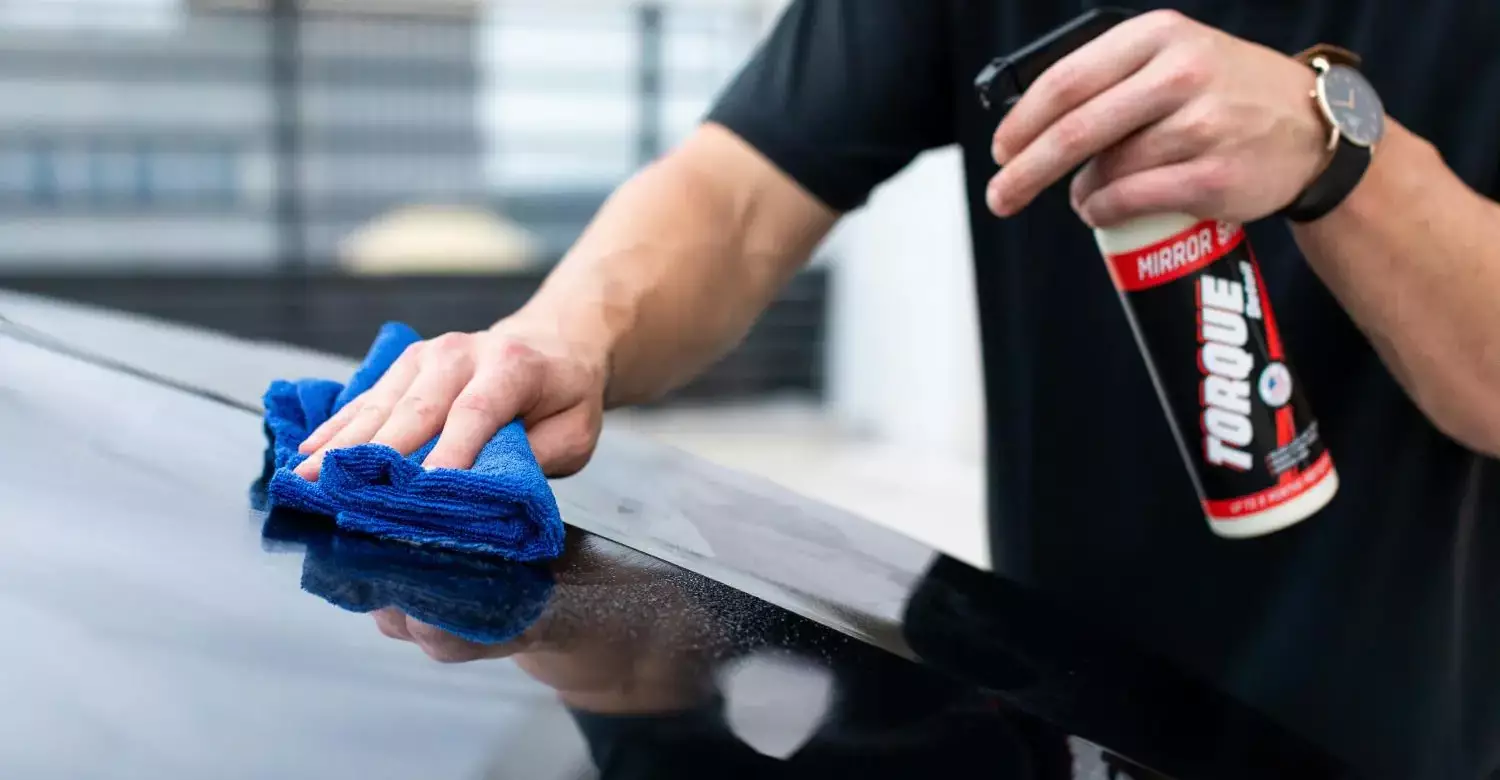
Waxing Techniques: Hand Waxing vs Machine Waxing
When it comes to waxing your car, two techniques can be used: hand waxing and machine waxing.
Hand Waxing
- Greater control over the wax application process, ensuring even coverage on your car’s paint
- More cost-effective than machine waxing
- Opportunity to inspect your car’s surface closely for any minor scratches or areas needing attention
- For car enthusiasts, the manual waxing process can be therapeutic and rewarding
Machine Waxing
Compared to hand waxing, machine waxing offers a quicker, more efficient way to apply wax to your car’s exterior. By using a dual-action polishing machine, you can achieve a smooth, even finish that’s hard to replicate by hand.
- Machine waxing covers large areas quickly, ideal for professional car detailing or larger vehicles
- Provides more consistent wax application, reducing the risk of uneven spots
- The precision of machine waxing can enhance the gloss and paint protection of your car’s coating
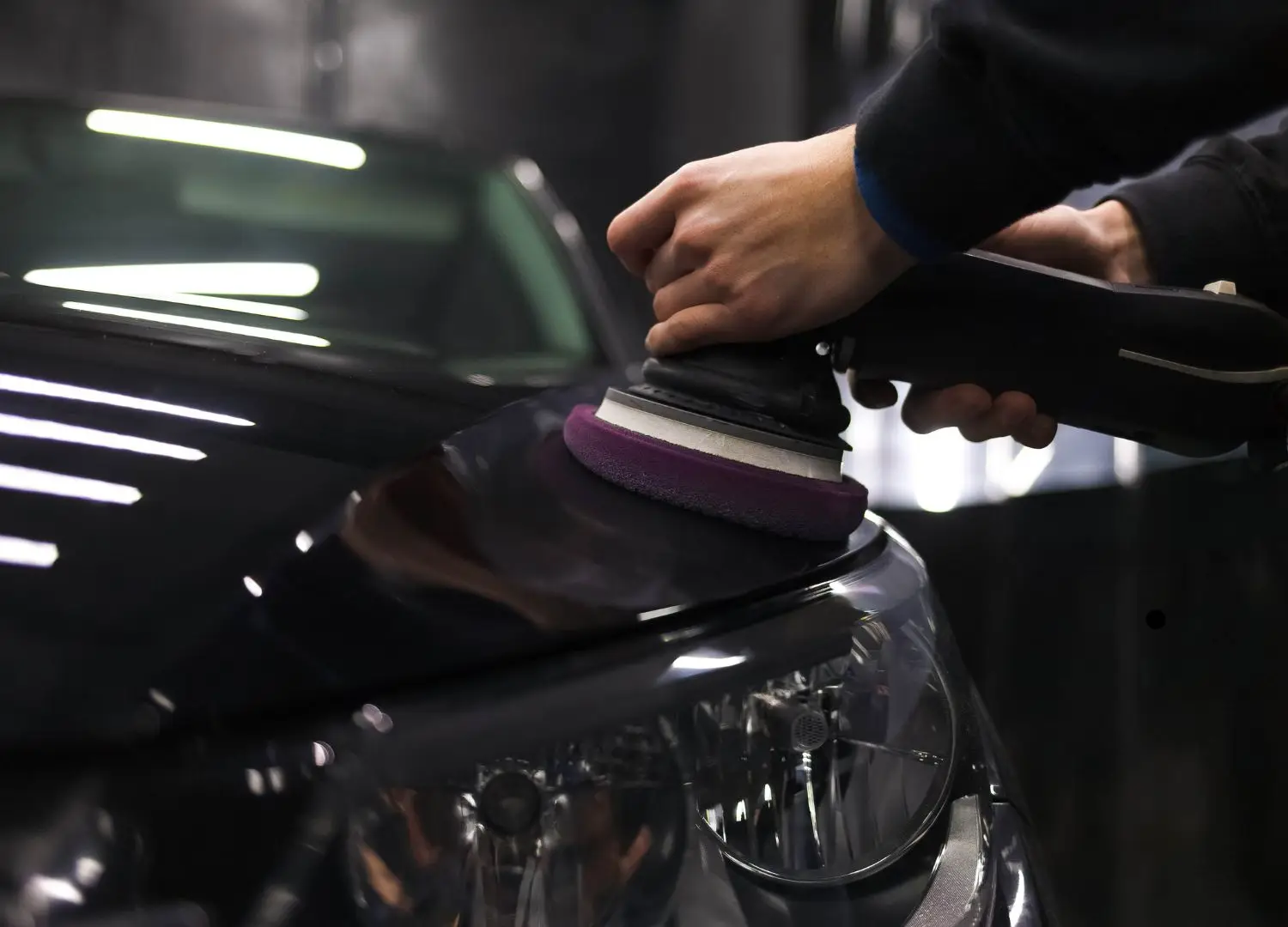
The Benefits of Waxing Your Car
Paint Protection From UV Rays
One significant benefit of waxing your car is the protection it provides against harmful UV rays, which can lead to fading and discoloration of your vehicle’s paint. Regular exposure to these rays can cause oxidation, a process that damages and dulls the finish.
Shield Against Harsh Weather
Car wax serves as a reliable shield against harsh weather conditions. Whether rain or snow, a layer of wax can be your car’s best defense. It creates a protective layer that repels water and prevents weather-related damage, including road salts.
Gives a Glossy Finish
Waxing enhances the look of your paintwork by giving it a glossy finish. The wax enhances the depth of the paint’s color and creates that showroom shine car owners love.
Improves Resale Value
Waxing your car regularly keeps it looking new, which improves its resale value. This protective layer preserves your car’s exterior appearance. Individual buyers and car dealerships prefer cars that have been well taken care of, so you’re likely to get a better deal when selling.
Improves Car Care Maintenance
Regular waxing makes it easier to wash and keep your car looking clean. The wax layer acts as a barrier between the clear coat and the elements, including dirt, dust, and road grime.
As a result, when it’s time to wash your car, you’ll find that contaminants wash away with less effort. Water beads and rolls off the waxed surface, preventing mineral deposits and water spots from forming. This means less scrubbing and reduced risk of scratch marks during the cleaning process.
Understanding Car Waxing vs Car Polishing
Polishing is typically the first step in enhancing your vehicle’s exterior, it’s meant to smooth out the surface and remove scratches from the paint, which prepares it for waxing. This addresses the main flaws in the exterior and boosts the overall shine of your car’s paint.
Waxing comes after polishing, and guards the paint against environmental damage. Waxing can be performed without polishing. Although polishing the paint removes scratches, applying wax alone can temporarily hide the scratches. However, as the wax wears off, any unaddressed scratches will become visible again. Therefore, while waxing can temporarily improve your car’s appearance, it’s better to polish before applying wax.
Wax Application Tips for Best Results
When you’re ready to wax your vehicle, avoid waxing in direct sunlight or extreme temperatures. Cool, shaded conditions for waxing produce the best results. Use a microfiber cloth for application and buffing to prevent scratch marks on your clear coat.
Apply the wax in thin, even layers rather than thick coats. A coat of wax should cover the surface completely but not be so thick that it’s difficult to buff off. Work in small sections to ensure proper coverage before the wax dries.
FAQs
Can You Wax a Car in Winter?
You can wax your car in winter, providing it with a protective barrier against the harsh effects of snow, road salt, and freezing temperatures. Winter wax application can actually help protect your car’s paintwork from damaging winter elements. Just ensure you’re working in a heated garage when temperatures drop too low.
Should You Wax Your Car Windows?
Yes, waxing your windows can improve visibility while driving. Window wax repels water and grime, preventing streaks and water spots that can obstruct your view. Use products specifically designed for glass rather than traditional car wax.
Can You Wax Your Car Yourself?
Absolutely! With the right wax products and a microfiber cloth, you can achieve professional waxing results. The car waxing process allows you to customize the approach based on your vehicle’s specific needs and your available time.
Can You Wax Your Car Without Polishing?
Yes, waxing without polishing is possible and can provide paint protection and a glossy finish. If your car’s paint is in good shape, you don’t always need to polish before you wax. Wax alone can fill minor imperfections and protect the exterior from harmful elements.
What’s the Wax Cost for DIY vs Professional?
DIY wax cost ranges from $10-50 for quality wax products that can last multiple applications. Professional wax services typically cost $100-300 depending on your vehicle size and the type of wax used. Consider your time investment when deciding between options.
Conclusion
Waxing your car is an essential part of car maintenance that keeps your vehicle protected and helps maintain its value. Whether you choose paste wax, liquid wax, or spray wax, regular wax application will keep your car looking its best while providing crucial paint protection.
If you are interested in professional vehicle waxing and auto detailing, contact Grandeur Autos today.
Our expertise extends across Calgary, where we’ve detailed numerous vehicles. Our services range from comprehensive interior detailing to thorough exterior care, ensuring your vehicle maintains its pristine condition.

